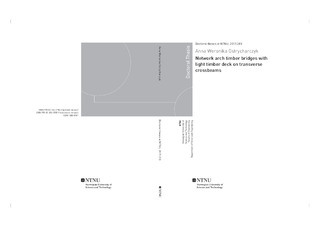| dc.contributor.advisor | Malo, Kjell Arne | |
| dc.contributor.author | Ostrycharczyk, Anna Weronika | |
| dc.date.accessioned | 2018-02-01T11:52:13Z | |
| dc.date.available | 2018-02-01T11:52:13Z | |
| dc.date.issued | 2017 | |
| dc.identifier.isbn | 978-82-326-2705-9 | |
| dc.identifier.issn | 1503-8181 | |
| dc.identifier.uri | http://hdl.handle.net/11250/2481196 | |
| dc.description.abstract | In modern bridge engineering, timber is more and more often considered as a choice for structural material. The advantages are evident: timber is environmentally friendly, easy to shape, thus it can meet various architectural requirements, and due to current technology, production of long elements of massive glulam is possible. However, due to the narrow history of wood research, in comparison to steel and concrete, this material is less familiar to the engineers. Therefore, the present situation can be amended increasing the research in the field.
The aim of this research project was to create a concept for a long-span timber bridge. Therefore, the idea of network arch, known among steel and concrete structures, was adapted to timber, i.e. in the studied bridge-type both the arch and the deck were made of glulam. For the chosen design concept, the focus of the research was on defining the network pattern suitable for bridges with light timber deck on transverse crossbeams, with equally distributed hangers along the lower chord. In addition, the concept of spoked configuration of hangers was verified. In order to perform such study, the work was divided into two phases: a preliminary study of a laboratory model and a wide-range parametric numerical study.
The scaled laboratory model was used as a benchmark for the validation of a single, detailed numerical model, which in turn was used as a basis to create a software tool for automatic model generation. The tool allows to build a bridge model with arbitrary geometrical, material and structural properties defined by a user.
The developed software was used to performed wide-range parametric studies. First, a comparison of selected existing network patterns with equally distributed hangers along the deck was made for two types of arch shape, i.e. circular and parabolic. Next, the focus of the numerical investigation was on the introduced radial pattern modifications. The influence of the presented pattern modifications on the structural performance of the network bridge, especially moment distribution in the arch, stresses in hangers and number of relaxed hangers, was evaluated for various load conditions. Finally, a possible alternative for wind bracing, i.e. spoked configuration of hangers, was analysed in terms of stability of the bridge.
In conclusion, the introduced pattern modifications have a positive influence on the forces distribution in the bridge structure, in comparison to the existing patterns. In addition, the modifications provide a way of a systematic pattern generation. Therefore, as such, they are promising for further development and application. Moreover, it was shown that spoked hangers configuration might reduce the amount of wind bracing, and consequently the number of side connections which are the main source of water penetration into timber elements. | nb_NO |
| dc.language.iso | eng | nb_NO |
| dc.publisher | NTNU | nb_NO |
| dc.relation.ispartofseries | Doctoral theses at NTNU;2017:318 | |
| dc.relation.haspart | Paper 1: Ostrycharczyk, Anna Weronika; Malo, Kjell Arne. Comparison of network patterns suitable for timber bridges with crossbeams.
Proceedings of the ICTB 2017, 3rd International Conference
on Timber Bridges | nb_NO |
| dc.relation.haspart | Paper 2: Ostrycharczyk, Anna Weronika; Malo, Kjell Arne. Parametric study of radial hanger patterns for network arch timber bridges with a light deck on transverse crossbeams. Engineering structures 2017 ;Volum 153. s. 491-502
https://doi.org/10.1016/j.engstruct.2017.10.021 | nb_NO |
| dc.relation.haspart | Paper 3:
Ostrycharczyk, Anna W; Malo, Kjell Arne.
Parametric study on effects of load position on the stress distribution in network arch timber bridges with light timber deck on transverse crossbeams - Is not included due to copyright | nb_NO |
| dc.relation.haspart | Paper 4:
Ostrycharczyk, Anna W; Malo, Kjell Arne.
Network arch timber bridges with light timber deck and spoked configuration of hangers – parametric
- Is not included due to copyright | nb_NO |
| dc.relation.haspart | Paper 5: Ostrycharczyk, Anna W; Malo, Kjell Arne. A review of serviceability limit state design criteria for timber footbridges. I: WCTE 2014, World Conference on Timber Engineering; Proceedings | nb_NO |
| dc.title | Network arch timber bridges with light timber deck on transverse crossbeams | nb_NO |
| dc.type | Doctoral thesis | nb_NO |
| dc.subject.nsi | VDP::Technology: 500::Building technology: 530::Construction technology: 533 | nb_NO |

